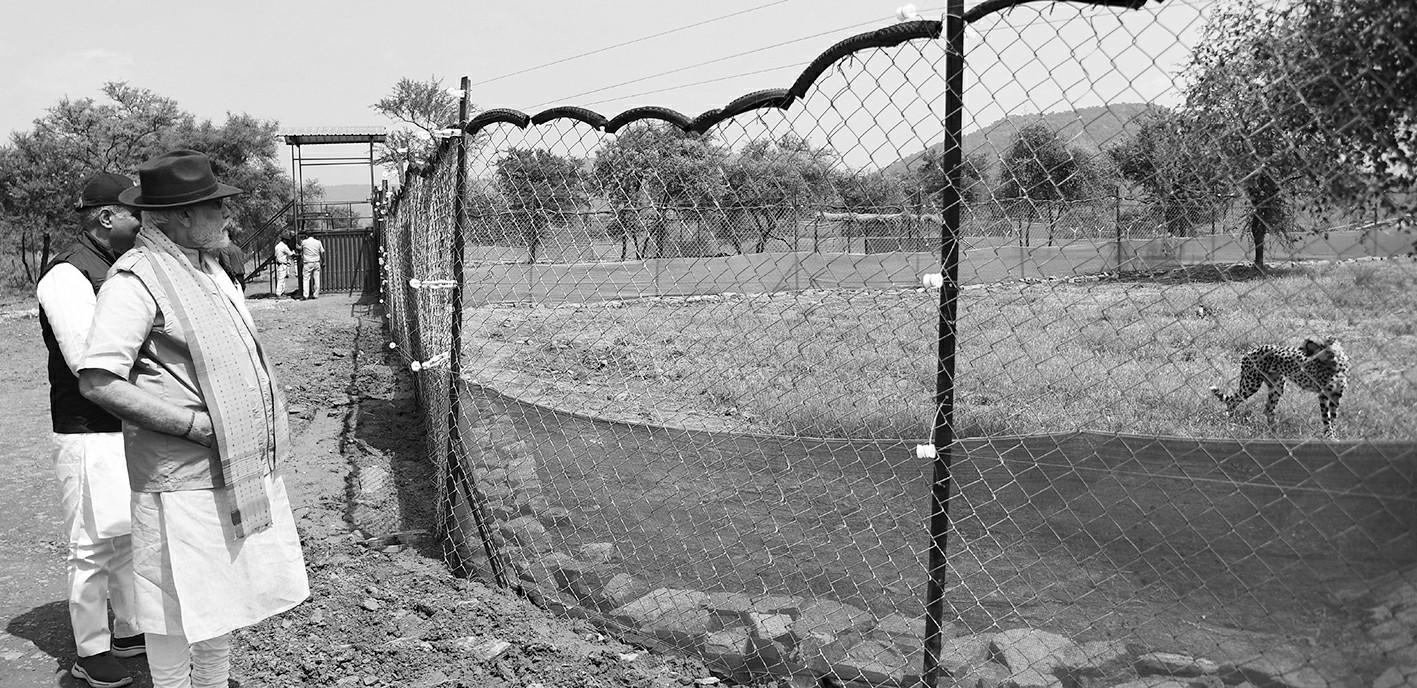Indian cheetah introduction plan is criticized for vanity
Author:Global Times Time:2022.09.19
Indian Prime Minister Modi ushered in his 72nd birthday on the 17th. Different from the past practice, Modi participated in a grand event in the Central Bangkino National Park in India this year: 8 cheetahs from Namibia were released here on the same day. "Playing Cheetah" has become one of the biggest gimmicks of Modi ’s birthday. However, from the perspective of some environmental protection and animal experts, the animal protection project of India is more like a vanity "face project".

On the 17th, Indian Prime Minister Modi hosted cheetah release activities in Kuno National Park. (Visual China)
Cheetah "return" Indian land
According to the British "Independence" reported on the 17th, Indian Prime Minister Modi was wearing a hunting clothing on the day and observed the "release" process of Cheetah at close range. Next to a metal fence in the park, Modi stood at the platform height, shook the iron door by himself, sent several cheetahs to the wild, and used a telephoto camera to record this rare moment from time to time. He said: "Decades ago, India's biodiversity since ancient times has broken. Today we have got an opportunity to repair it ... Cheetah returned to India's land."
According to the BBC, eight cheetahs introduced from Namibia include 3 male and 5 females. They were transported to Kuno National Park by a helicopter after arriving at India by plane. Strictly speaking, Modi's activities that day were not "released". He just put the cheetah from the cage to the isolation point of the national park. 8 cheetahs will be separated for about a month before being sent to the vast land of the National Park. The area of Kuno National Park is about 750 square kilometers, and animals such as antelopes and pigs in the park can be predated by cheetahs. However, even if the cheetah really "returns to the wilderness" in the future, it will also wear positioning collars, and its whereabouts will receive close attention from staff.
According to the Indian government's plan, the country will introduce 12 cheetahs from South Africa next month, and hopes that they can reproduce in the protected area to increase the number of cheetahs to 40. The Indian government will spend 910 million rupees (about 80 million yuan) for this "Cheetah Plan", of which most of them are borne by state -owned enterprises India Petroleum Corporation.
A wave of twists and turns "cheetah introduction"
Reuters said that when it comes to cheetahs, people often think of Africa. In fact, this animal was widely distributed on the Indian continent in the early years. During the Mughal dynasty, Wang Gonggui liked to domesticate cheetah to help hunting. With the loss of habitats and out of control, the number of Indian cheetahs continued to decrease, and eventually announced its extinction in 1952.
India has tried to re -introduce cheetah for a long time, and governments at all levels have experienced decades of research and negotiations, and even considered "cloned". In the 1970s, the Indian Ministry of Environment had sent a letter to Iran, hoping that the country could assist India to introduce Asian cheetahs. The negotiations finally had eyebrows, but did not want the Iranian revolution to explode, and those who were original power were stopped, and the cheetah plan was stranded. In August 2009, the then Minister of the Environment of India restarted negotiations with Iran, but at that time, the number of Asian cheetahs in Iran was not large. Iran also tried to exchange rare Asian lions with India, and finally the negotiations completely ruptured in 2010.
After that, India tried to introduce cheetahs from African countries. The countries that have been inspected include Kenya, Tanzania, Botswana, South Africa and other countries. At that time, the Indian government was relatively conservative to the number of introductions. The original plan was about 5 to 10 one after another within 5 to 10 years. Even so, the plan still caused widespread controversy. In 2012, the Supreme Court of India made the plan stopped on the grounds that the government failed to introduce scientific research and suspected of violating the country's "Wildlife Protection Law". As the Indian National Tiger Protection Bureau began to actively intervene, the Supreme Court finally turned on a green light for the introduction of the introduction in January 2020.
Classified "Face Project"
In fact, the Indian cheetah's introduction plan is still controversial. Many environmental scholars said that this plan of the Modi government is simply the "face project". The African cheetah and Asian cheetah introduced by the country are only "distant relatives", and the former never belongs to the Indian continent. Some experts said that the territory required by Cheetahs is very positive. 100 square kilometers can accommodate 6 to 11 tigers, but can only accommodate the next cheetah. Under the circumstances of "competing" land of 1.4 billion people in India, whether cheetah can have enough living space to be worried.
Wildlife protection expert Tapar said that the Indian authorities have no experience in the wild survival of cheetahs. These cheetahs are likely to "only survive in the short term" in national parks. In his opinion, the Indian government should concentrate financial resources and manpower to protect local endangered animals. According to media reports, in order to give these foreign "Jiao Ke", the local government has reorganized the villagers near Kuno National Park. The wildlife protection department also carefully calculated the number of prey in the park to ensure that cheetahs can be full. Some people say that this operation is enough to "labor and the people." There are also different opinions that Cheetah plays an important role in the ecological environment, and India's current plan is "worth trying." ▲
The newspaper in Pakistan, a special reporter Cheng, a special reporter Liu Haoran
- END -
The 14th Global Chinese Chemical Scholars Symposium was held in Guangzhou

On August 13, the 14th Global Chinese Chemical Scholars Symposium was held in Guan...
New deployment to Russia?Let the Arctic become "NATO's Arctic"?

When the Russian -Ukraine conflict is still stuck, NATO, which is constantly armin...